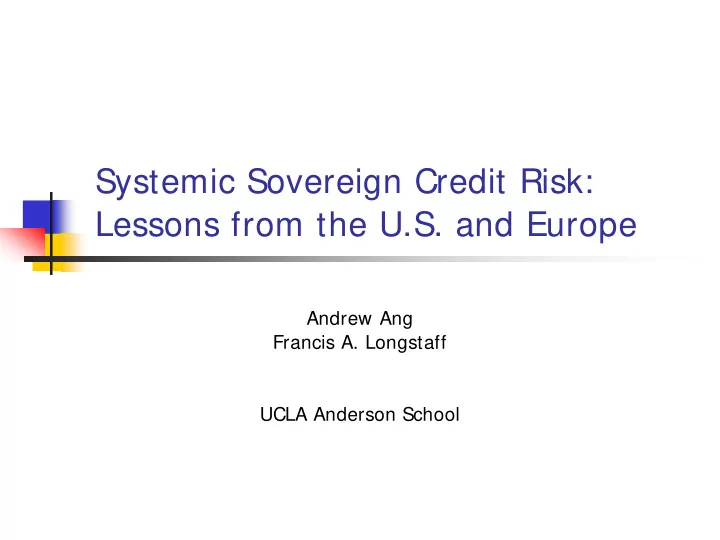

Systemic Sovereign Credit Risk: Lessons from the U.S. and Europe Andrew Ang Francis A. Longstaff UCLA Anderson School
Overview Sovereign credit risk. The ongoing European debt crisis. Recent U.S. Treasury downgrade. Increasing concerns about the solvency of U.S. states. The ever widening ripples from these shocks have affected many other financial markets and have raised fears that sovereign credit risk may be far more systemic that previously anticipated. How much of sovereign credit risk is systemic? What drives systemic sovereign credit risk?
Overview This paper provides a new perspective on systemic credit risk by studying and contrasting the credit risk of sovereigns within two important currency unions: The Eurozone. The U.S. The study makes use of a novel set of sovereign CDS spread data for the U.S. and individual states that has just become available. U.S. states are sovereign borrowers since under the U.S. Constitution, they may repudiate their debts without borrowers being able to claim assets in a bankruptcy process. Differs from Municipalities which are subject to Chapter 9.
Overview Given that states have tighter fiscal, political, and economic linkages that is the case within the Eurozone, we would expect that there is greater systemic risk among U.S. sovereigns. We find that the opposite is true: Only 12% of U.S. sovereign credit risk is systemic. In contrast, 31% of Eurozone credit risk is systemic. Correlations of CDS spreads are higher in Europe. Results provide evidence against the hypothesis that tighter macroeconomic linkages lead to higher levels of systemic risk. We must look elsewhere to understand the source of systemic sovereign credit risk.
Overview We find that the systemic credit risk of both the U.S. and the Eurozone is strongly related to financial market factors: Systemic risk declines as stock markets rally. Systemic risk declines as corporate bond markets rally. Systemic risk in the U.S. increases as financial firms funding costs increase. Systemic risk in both Europe and the U.S. is tightly linked to China. Increases in market volatility reduces U.S. systemic risk—flight to quality benefits? These results suggest that systemic sovereign risk has its roots in financial markets rather than in macroeconomic fundamentals.
Systemic Risk There are many definitions of systemic risk in the literature. We use the Duffie and Singleton (2003) multivariate credit model. In this setting, default happens in one of two ways. When a sovereign defaults for country-specific reasons. When an economic shock occurs that could potentially affect all countries. After the shock, each sovereign now has some probability of defaulting, where the probability may differ across sovereigns. Thus, multiple defaults can occur in the wake of a shock. Furthermore, each sovereign’s probability of default given a shock measures its degree of systemic risk.
Recommend
More recommend